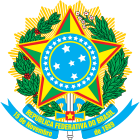| This article is part of a series on the |
 |
|---|
The Federal Territories of Brazil (Portuguese: Territórios Federais do Brasil) are sub-national administrative divisions overseen by the federal government of Brazil. Unlike the other federative units of Brazil, the federal territories are directly administered by the federal government. The 1988 Constitution of Brazil was the final constitution create formal regulations to regulate the establishment and disestablishment of federal territories. Federal territories can be created from other federative units after a successful plebiscite involving the affected residents. They can either be dissolved by elevation to new states or reintegration into the federative units that they were dismembered from.
If a new territory is created, it can have municipalities (unlike state and federal districts) and will elect four federal deputies, regardless of its location, territorial size, socio-economic conditions, population size and even electorate. The Territories have no Senators because they are not Federal Entities, being linked to the Union. (sourced in 1988 constitution) If a federal territory has more than 100 thousand residents, it'l have a governor elected directly by the president and judicial power, a Public Prosecutor's Office, and a Public Defender's Office
Brazil does not currently have any federal territories. The 1988 Constitution abolished all three territories then existing: Fernando de Noronha became a state district of the state of Pernambuco, and the Federal Territory of Amapá and the Federal Territory of Roraima were elevated to statehood.
